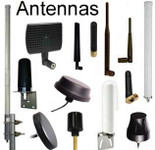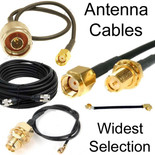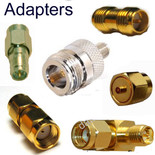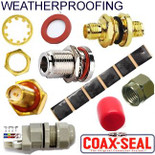Antennas, Antenna Cables, Wireless Products: Technical Articles
Comparison of LMR-100, LMR-200 and LMR-400 Coax for Antenna Cables
Table of Contents
Signal Loss, Specifications and Composition of LMR-100, LMR-200 and LMR-400 Compared
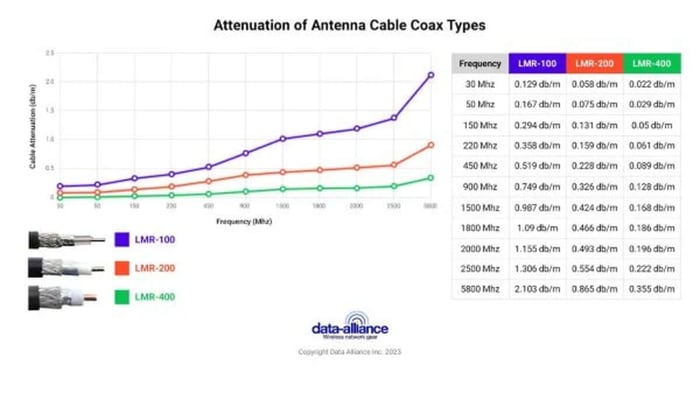
Attenuation is Loss of Signal in the Cable
Double shielding benefits: LMR-100, LMR-200 and LMR-400
The double shielded composition of LMR-100, LMR-200 and LMR-400 enables far better preservation of signal strength than the single-shielded coax types that they are most typically compared to (RG-174, RG-58 as examples): The LMR-100, 200 and 400 coax types have in-built shielding from both an aluminum layer providing 100% coverage and a denser copper braiding layer. This combination of shield layers leads to a minimal loss cable and also one that effectively blocks out external interference.
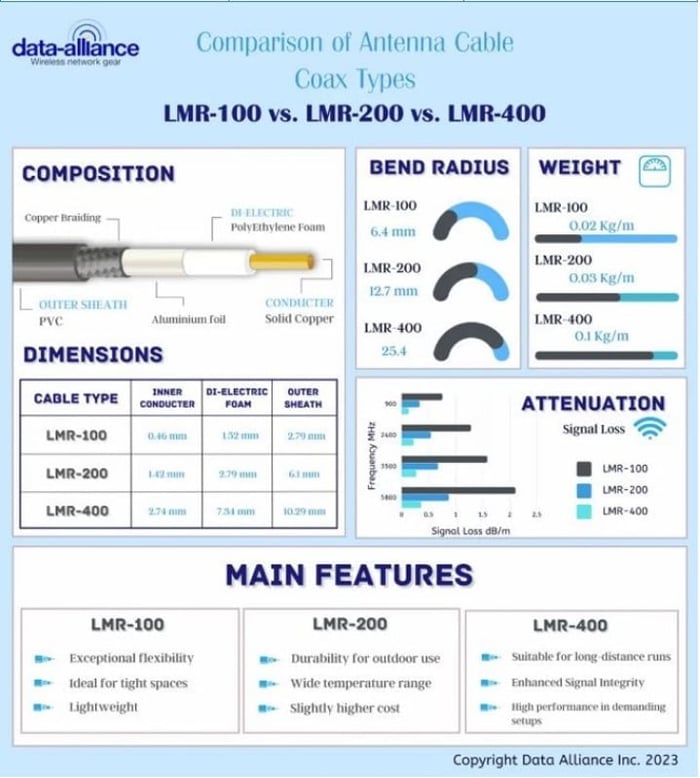
Attenuation (Loss of Signal): How do LMR-100, 200 & 400 compare?
As classified as low loss, you can probably imagine they all fare well in this category. But for further detail, please read on:
* For detailed information on the terms dBi, dB, dBm, and dB(mW) *
At 900 MHz
- LMR-100 = 0.75 dB/m. (0.23 dB/ft.)
- LMR-200 = 0.33 dB/m. (0.09 dB/ft.)
- LMR-400 = 0.13 dB/m. (0.039 dB/ft.)
At 2400 MHz
- LMR-100 = 1.28 dB/m. (0.39 dB/ft.)
- LMR-200 = 0.54 dB/m. (0.12 dB/ft.)
- LMR-400 = 0.22 dB/m. (0.066 dB/ft.)
At 3500 MHz
- LMR-100 = 1.58 dB/m. (0.48 dB/ft.)
- LMR-200 = 0.67 dB/m. (0.21 dB/ft.)
- LMR-400 = 0.27 dB/m. (0.081 db/ft.)
At 5800 MHz
- LMR-100: 2.10 dB/m. (0.64 dB/ft.)
- LMR-200: 0.87 dB/m. (0.264 dB/ft.)
- LMR-400: 0.36 dB/m. (0.108 dB/ft.)
| Frequency | LMR-100 Attenuation (dB/m) | LMR-200 Attenuation (dB/m) | LMR-400 Attenuation (dB/m) |
| 900 MHz | 0.75 | 0.33 | 0.13 |
| 2400 MHz | 1.28 | 0.54 | 0.22 |
| 3500 MHz | 1.58 | 0.67 | 0.27 |
| 5800 MHz | 2.10 | 0.87 | 0.36 |
Composition
Taking a look into the technical features (composition) of the coaxial cables, we will summarize conclusions about how they contribute to the user benefits (advantages):
- Copper clad-steel conductor - an excellent carrier of radio frequency signal, ideal for almost any cabling challenge
- Dielectric PE foam - a superior dampener of loss of electromagnetic radiation
- Double shielding - aluminium sheet plus copper braiding for maximum preservation of signal strength across length of cable
- Outer Jacket - a robust finish, ideal for maintaining functional excellence in physically challenging environments
1. Inner conductor
- LMR-100 conductor: approximately 0.46 mm (0.02 inches) in diameter
- LMR-200 conductor: approximately 1.42 mm (0.06 inches) in diameter
- LMR-400 conductor: above 2.74 mm (0.11 inches) in diameter
2. Dielectric foam diameter & material
- LMR-100 foam diameter: 1.52 mm (0.01 inches), Polyetylene foam
- LMR-200 foam diameter: 2.79 mm (0.001 inches), Polyethylene foam
- LMR-400 cable sheath: 7.24 mm, (0.29 inch) Polyethylene foam
3. Inner shield
- All copper braiding
4. Outer shield
- All aluminium layer
5. Outer cable sheath diameter, material & color
- LMR-100 cable sheath: approximate 2.79 mm (0.11 inches) diameter, Polyethylene black
- LMR-200 cable sheath: approximately 6.1 mm (0.24 inches) in diameter, Polyethylene, black
- LMR-400 cable sheath: above 10.29 mm (0.41 inches) in diameter, Thermoplastic elastomer, black
Other qualities which the LMR-100, LMR-200 & LMR-400 have...
Temperature stability = operable unto 85-degrees C maximum temperature and a minimum of -40-degrees C. Hot or cold, your LMR coaxial cables are adept at doing well. Bending radius = the LMR-100, LMR-200 and LMR-400 have respective bend radii of: 6.4 mm (0.25 inches), 12.7 mm (0.5 inches) and 25.4 mm (1.0 inches). Agile, without question. Weight = as all-rounders, consideration has been applied to their overall weight for ease of installation. The weights are as follows: LMR-100 0.02 kg/m (0.013 lbs/ft), LMR-200 0.03 kg/m (0.02 lbs/ft) and LMR-400 0.10 kg/m (0.068 lbs/ft) Each cable is made conscientiously without the use of halogens according to standard health and safety protocol.
LMR-100, LMR-200 & LMR-400 are double-shielded, low signal-loss coaxial cable types for antenna cables. As closely related "sister" coax types, they each share commonly associated characteristics and possess comparable benefits. Their purpose is simply to convey radio frequency transmitted signals across physical distance, with minimal loss or interference. Here are some typical application scenarios:
- HDTV deployment,
- Broadband internet networks,
- CCTV,
- Video
- Radio
- Antenna runs
- Wireless assemblies
- WLAN
- GPS
Conclusion
LMR-100, LMR-200, and LMR-400 coaxial cables are engineered for reliable RF signal transmission with low attenuation and strong protection against interference. Their double-shielded design, high-quality materials, and wide operating temperature range make them dependable for a variety of wireless and communication applications. While LMR-100 offers flexibility for short runs, LMR-200 provides a balance of performance and size, and LMR-400 delivers the lowest signal loss over long distances. Together, they offer scalable solutions to meet different installation needs with consistent durability and efficiency.
FAQs
What is attenuation in coaxial cables?
Attenuation refers to the loss of signal strength as it travels through a cable. It is measured in decibels per meter (dB/m) and increases with cable length and frequency.
What makes LMR cables low-loss compared to other coaxial cables like RG-58 or RG-174?
LMR-100, LMR-200, and LMR-400 use double shielding—an aluminum foil layer plus copper braid—which provides superior protection from interference and reduces signal loss.
How do LMR-100, LMR-200, and LMR-400 compare in terms of signal loss?
Signal loss decreases as cable size increases:
- LMR-100 has the highest attenuation (best for short runs)
- LMR-200 offers moderate loss
- LMR-400 has the lowest attenuation (best for long-distance runs)
What are typical applications for LMR coaxial cables?
LMR cables are used in:
- Antenna extensions
- Wireless networks (Wi-Fi, WLAN)
- GPS
- Broadband internet
- CCTV systems
- HDTV
- Radio and video communications
What materials are LMR cables made from?
They feature a copper-clad steel conductor, polyethylene (PE) dielectric foam, aluminum foil shield, copper braid, and a durable black outer jacket.
Why does cable diameter matter?
Thicker cables like LMR-400 have larger conductors, which reduce resistance and signal loss, making them ideal for long runs. Smaller cables like LMR-100 are more flexible but lose more signal over distance.
Are LMR cables suitable for outdoor use?
Yes. Their UV-resistant outer jackets and wide operating temperature range (-40°C to +85°C) make them ideal for outdoor installations.
What are the bending and handling characteristics of LMR cables?
LMR cables are designed to be flexible and easy to install:
- LMR-100: smallest bend radius (6.4 mm), ideal for tight spaces
- LMR-200: medium flexibility (12.7 mm)
- LMR-400: stiffer but still manageable (25.4 mm)

